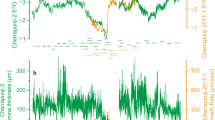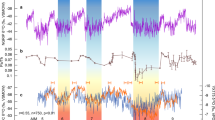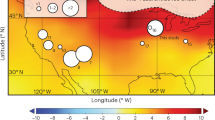Abstract
Understanding the relative timings of climate events in the Northern and Southern hemispheres is a prerequisite for determining the causes of abrupt climate changes. But climate records from the Patagonian Andes1,2,3,4 and New Zealand5,6,7,8 for the period of transition from glacial to interglacial conditions—about 14.6–10 kyr before present, as determined by radiocarbon dating—show varying degrees of correlation with similar records from the Northern Hemisphere. It is necessary to resolve these apparent discrepancies in order to be able to assess the relative roles of Northern Hemisphere ice sheets and oceanic, atmospheric and astronomical influences in initiating climate change in the late-glacial period. Here we report pollen records from three sites in the Lake District of southern Chile (41° S) from which we infer conditions similar to modern climate between about 13 and 12.2 14C kyr before present (bp), followed by cooling events at about 12.2 and 11.4 14C kyr bp, and then by a warming at about 9.8 14C kyr bp. These events were nearly synchronous with important palaeoclimate changes recorded in the North Atlantic region9, supporting the idea that interhemispheric linkage through the atmosphere was the primary control on climate during the last deglaciation. In other regions of the Southern Hemisphere, where climate events are not in phase with those in the Northern Hemisphere, local oceanic influences may have counteracted the effects that propagated through the atmosphere.
This is a preview of subscription content, access via your institution
Access options
Subscribe to this journal
Receive 51 print issues and online access
$199.00 per year
only $3.90 per issue
Buy this article
- Purchase on Springer Link
- Instant access to full article PDF
Prices may be subject to local taxes which are calculated during checkout



Similar content being viewed by others
References
Denton, G. H. et al. Interhemispheric linkage of paleoclimate during the last glaciation. Geogr. Ann. A 81, 107–155 (1999).
Lowell, T. V. et al. Interhemispheric correlation of Late Pleistocene glacial events. Science 269, 1541–1549 (1995).
Zhou, M. & Heusser, C. J. Late-glacial palynology of the Myrtaceae of Chile. Rev. Palaeobot. Palynol. 91, 283–315 (1996).
Bennett, K. D., Haberle, S. G. & Lumley, S. H. The last glacial-Holocene transition in Southern Chile. Science 290, 325–328 (2000).
Denton, G. H. & Hendy, C. H. The age of the Waiho Loop glacial event. Science 271, 668–670 (1995).
Denton, G. H. & Hendy, C. H. Younger Dryas age advance of Franz Josef Glacier in the Southern Alps of New Zealand. Science 264, 1434–1437 (1994).
Singer, C., Shulmeister, J. & McLea, B. Evidence against a significant Younger Dryas cooling event in New Zealand. Science 281, 812–814 (1998).
Newnham, R. M. & Lowe, D. J. Fine-resolution pollen record of late-glacial climate reversal from New Zealand. Geology 28, 759–762 (2000).
Björk, S. et al. An event stratigraphy for the Last Termination in the North Atlantic region based on the Greenland ice-core record: a proposal by the INTIMATE group. J. Quat. Sci. 13, 281–292 (1998).
Villagrán, C. Vegetatiosgeschichtliche und pflanzensoziologische Untersuchungen im Vicente Perez Rosales National park (Chile). Diss. Bot. 54, 1–165 (1980).
Páez, M. M., Villagrán, C. & Carrillo, R. Modelo de la dispersión polínica actual en la región templada chileno-argentina de Sudamérica y su relación con el clima y la vegetación. Rev. Chil. Hist. Nat. 67, 417–434 (1994).
Mercer, J. H. Glacial history of southernmost South America. Quat. Res. 6, 125–166 (1976).
Mercer, J. H. Chilean glacial chronology 20,000 to 11,000 carbon-14 years ago: some global comparisons. Science 172, 1118–1120 (1972).
Porter, S. C. Pleistocene glaciation in the southern lake district of Chile. Quat. Res. 16, 263–292 (1981).
Lusk, C. H. Gradient analysis and disturbance history of temperate forests of the coast range summit plateau, Valdivia, Chile. Rev. Chil. Hist. Nat. 69, 401–411 (1996).
Lusk, C. H. Long-lived light-demanding emergents in southern temperate forests: the case of Weinmannia trichosperma (Cunoniaceae) in southern Chile. Plant Ecol. 140, 111–115 (1999).
Ramírez, C. in Monte Verde, a Late Pleistocene Settlement in Chile Vol. I, Paleoenvironment and Site Context 53–87 (Smithsonian Institution Press, Washington, 1989).
Dillehay, T. Monte Verde, a Late Pleistocene Settlement in Chile. Vol. II, The Archaeological Context and Interpretation (ed. Gould, R. A.) (Smithsonian Institution Press, Washington, 1997).
Ariztegui, D., Bianchi, M. M., Masaferro, J., Lafargue, E. & Niessen, F. Interhemispheric synchrony of late-glacial climatic instability as recorded in proglacial Lake Mascardi, Argentina. J. Quat. Sci. 12, 333–338 (1997).
Charles, C. D., Lynch-Stieglitz, J., Ninnemann, U. S. & Fairbanks, R. G. Climate connections between the hemispheres revealed by deep sea sediment core/ice core correlations. Earth Planet. Sci. Lett. 142, 19–27 (1996).
Sowers, T. & Bender, M. Climate records covering the last deglaciation. Science 269, 210–214 (1995).
Broecker, W. S. & Denton, G. H. The role of ocean-atmosphere reorganizations in glacial cycles. Quat. Sci. Rev. 9, 305–341 (1989).
Broecker, W. S. Massive iceberg discharges as triggers for global climate change. Nature 972, 421–424 (1994).
Broecker, W. S. Paleocean circulation during the last deglaciation: A bipolar seesaw? Paleoceanography 13, 119–121 (1998).
Acknowledgements
We thank I. Hajdas, W. Beck and T. Jull for their contribution to the development of the radiocarbon chronology of Canal de la Puntilla and Huelmo sites. This work was supported by the Office of Climate Dynamics of NSF, NOAA, the National Geographic Society, the Geological Society of America, the EPsCOR program of NSF, and a Fondecyt grant.
Author information
Authors and Affiliations
Corresponding author
Rights and permissions
About this article
Cite this article
Moreno, P., Jacobson, G., Lowell, T. et al. Interhemispheric climate links revealed by a late-glacial cooling episode in southern Chile. Nature 409, 804–808 (2001). https://doi.org/10.1038/35057252
Received:
Accepted:
Issue Date:
DOI: https://doi.org/10.1038/35057252
This article is cited by
-
Sedimentary record from Patagonia, southern Chile supports cosmic-impact triggering of biomass burning, climate change, and megafaunal extinctions at 12.8 ka
Scientific Reports (2019)
-
Comparison of modern pollen distribution between the northern and southern parts of the South China Sea
International Journal of Biometeorology (2015)
-
North Atlantic forcing of tropical Indian Ocean climate
Nature (2014)
-
The Southern Westerlies during the last glacial maximum in PMIP2 simulations
Climate Dynamics (2009)
Comments
By submitting a comment you agree to abide by our Terms and Community Guidelines. If you find something abusive or that does not comply with our terms or guidelines please flag it as inappropriate.



